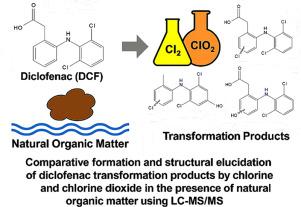Comparative formation and structural elucidation of diclofenac transformation products by chlorine and chlorine dioxide in the presence of aquatic humic substances (AHS) using LC-MS/MS
IF 6.7
2区 工程技术
Q1 ENGINEERING, CHEMICAL
引用次数: 0
Abstract
Diclofenac (DCF), a widely used non-steroidal anti-inflammatory drug, frequently occurs in surface and drinking water sources and has raised concerns due to its environmental persistence and potential toxicity. This study investigated the oxidative degradation of DCF and formation of transformation products (TPs) using chlorine (Cl₂) and chlorine dioxide (ClO₂), both in purified and synthetic waters containing aquatic humic substances (AHS), representative of tropical surface waters. Chlorine achieved >90 % DCF removal within 12 h in purified water and >80 % in synthetic water, generating a broader spectrum of TPs, including chlorinated, hydroxylated, and decarboxylated derivatives. In contrast, ClO₂, even at a low dose of 0.5 mg L−1, removed >99 % of DCF within 30 min in purified water and formed fewer TPs, suggesting a trade-off between oxidative efficiency and byproduct minimization. LC-MS/MS analysis enabled detailed structural elucidation of major TPs, with m/z values and fragmentation patterns supporting the identification of chlorinated and hydroxylated intermediates. The presence of AHS reduced DCF degradation rates while modulating TPs profiles, likely through competitive oxidant consumption and the formation of humic-bound conjugates. These findings underscore the importance of accounting for transformation products in water treatment design and highlight the need for ecotoxicological evaluation of TPs under tropical surface water conditions.

在水生腐殖质(AHS)存在下,氯和二氧化氯对双氯芬酸转化产物形成和结构的比较分析
双氯芬酸(DCF)是一种广泛使用的非甾体抗炎药,经常出现在地表水和饮用水源中,由于其环境持久性和潜在毒性而引起关注。本研究在以热带地表水为代表的含水生腐殖质(AHS)的纯净水和合成水中,研究氯(Cl₂)和二氧化氯(ClO₂)对DCF的氧化降解和转化产物(TPs)的生成。在纯净水中,氯在12小时内达到90%的DCF去除率,在合成水中达到80%,产生更广泛的TPs,包括氯化、羟基化和脱羧衍生物。相比之下,即使在0.5 mg L−1的低剂量下,ClO₂也能在30分钟内去除净化水中99%的DCF,并形成更少的TPs,这表明在氧化效率和副产物最小化之间存在权衡。LC-MS/MS分析能够详细阐明主要tp的结构,m/z值和片段模式支持氯化和羟基化中间体的鉴定。AHS的存在降低了DCF的降解率,同时调节了TPs的分布,可能是通过竞争性氧化剂消耗和腐殖质结合偶联物的形成。这些发现强调了在水处理设计中考虑转化产物的重要性,并强调了在热带地表水条件下对TPs进行生态毒理学评估的必要性。
本文章由计算机程序翻译,如有差异,请以英文原文为准。
求助全文
约1分钟内获得全文
求助全文
来源期刊

Journal of water process engineering
Biochemistry, Genetics and Molecular Biology-Biotechnology
CiteScore
10.70
自引率
8.60%
发文量
846
审稿时长
24 days
期刊介绍:
The Journal of Water Process Engineering aims to publish refereed, high-quality research papers with significant novelty and impact in all areas of the engineering of water and wastewater processing . Papers on advanced and novel treatment processes and technologies are particularly welcome. The Journal considers papers in areas such as nanotechnology and biotechnology applications in water, novel oxidation and separation processes, membrane processes (except those for desalination) , catalytic processes for the removal of water contaminants, sustainable processes, water reuse and recycling, water use and wastewater minimization, integrated/hybrid technology, process modeling of water treatment and novel treatment processes. Submissions on the subject of adsorbents, including standard measurements of adsorption kinetics and equilibrium will only be considered if there is a genuine case for novelty and contribution, for example highly novel, sustainable adsorbents and their use: papers on activated carbon-type materials derived from natural matter, or surfactant-modified clays and related minerals, would not fulfil this criterion. The Journal particularly welcomes contributions involving environmentally, economically and socially sustainable technology for water treatment, including those which are energy-efficient, with minimal or no chemical consumption, and capable of water recycling and reuse that minimizes the direct disposal of wastewater to the aquatic environment. Papers that describe novel ideas for solving issues related to water quality and availability are also welcome, as are those that show the transfer of techniques from other disciplines. The Journal will consider papers dealing with processes for various water matrices including drinking water (except desalination), domestic, urban and industrial wastewaters, in addition to their residues. It is expected that the journal will be of particular relevance to chemical and process engineers working in the field. The Journal welcomes Full Text papers, Short Communications, State-of-the-Art Reviews and Letters to Editors and Case Studies
 求助内容:
求助内容: 应助结果提醒方式:
应助结果提醒方式:


